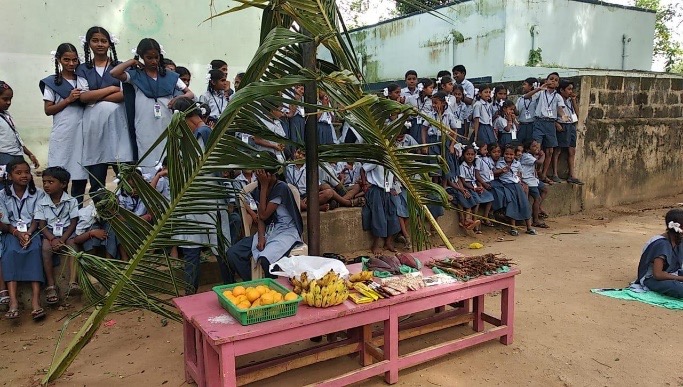Lesson: Economics-An Introduction
A description of an event at school that provided a hands-on experience of the knowledge of buying, selling, value of goods, profit and loss, and demand and supply to the students through activities.
I have employed various techniques to teach the lesson “Economics – An Introduction”. A fun-filled and at the same time powerful way of understanding the trading system is to make students get involved in the marketing system. Such a method will help students to acquire a direct knowledge regarding buying, selling, value of goods, profit and loss, and demand and supply.

Figure 1 Teachers helped the students organize the festival

Figure 2 Students eagerly participating in the 'Sandhai'
In order to make the students learn the basics of the trading system, I had planned ‘KEEZHUR GRAMA SANTHAI’ (Keezhur Village Market) in our school. Our students were instructed to bring some consumer goods which were available in their houses and in their neighboring locality. They were instructed to bring supplementary materials, such as sacks, cloth/jute bags, price lists, etc., that would be useful for them to setting up the display at their stalls.
I had made some arrangements well in advance for the programme, such as putting up a board to welcome people, getting decorative materials like coconut leaves, Pathaneer (பதநீர்), etc., and arranging for speakers to make announcements.
Students of the other classes were also informed about the programme that was being organized, and they were instructed to bring cloth/jute bags and a small amount of money that is needed to buy things in the Santhai.
The students were given strict instructions on not to use plastic bags.
On the day of the event, my students brought coconuts, papayas, citrons, sugarcanes, and others fruits and vegetables, and we started to display those items at their stalls. We used our school ground to display the items in separate stalls. Some students also brought boards that displayed “கடன் கிடையாது” (“No loans”) the price list of the goods in their stalls, and a separate box to collect money.

Figure 3 A student with his saleables
The Santhai was inaugurated by the headmaster of our school, Thiru. E. Sridhar. A brief introduction about the event was presented by our Tamil teacher Mr. P. Nilavazhagan (TGT). He composed a beautiful Tamil kavithai (poem) and recited it for the occasion. It was a fabulous recitation, and the students enjoyed his a lot.
கொட்டி வைத்த நெல்லிக்கனி
குட்டிக்குட்டி வெள்ளரிக்காய்
வெட்டி வைத்தக் கிழங்குவகை
எட்டுப் போன்ற வேர்க்கடலை
தட்டு வண்டி நிறைய
மூட்டைப்போல குவிந்திருக்க
தறி கெட்ட மனிதர் கண்ணில்
பட்டதெல்லாம் அவையல்ல
கெட்டுப்போன உணவைத் தேடி
கெடு நினைவில் அலைகின்றோம்
பொரித்து வைத்தத் தின்பண்டம்
செரிக்காத வன்உணவு சுவையெனவே எண்ணுகின்றோம்
பச்சைக் காய்கறிகள் பழவகைகள் பல இருக்க
கொச்சை உணவை கூசாமல் உண்ணுகின்றோம்
கைக்குத்தல், களிசோறு, கம்பங்கூழ் காலம்மாறி
பஃப்பே, பாஸ்ட்புட் என திசைமாறி திரிகின்றோம்
பட்டுடை அணிந்து பருத்தியை மறந்ததுபோல்
கட்டுடலைக் குலைக்கின்ற கொல்லுணவை உண்ணுகின்றோம்
உழவன் விளைவித்த நல்லுணவை நாளும் உண்டு
கிழவன் ஆகும்வரை கீர்த்தியுடன் வாழ்ந்திடுவோம்.
The first purchases were made by our beloved headmaster and the teachers. Some of the students of the primary school did not bring money. However, our teachers bought them things so that they would be able to enjoy the Santhai festival as well.
My students learnt how to fix the selling price, how to attract the customers towards their stalls, and how to gain profits with their materials indirectly through this festival. Each student followed different techniques to sell their goods. Some students sold Palmyra tuber and Moringa in bundles (கத்தை), Sugarcanes (a single piece of sugarcane is called pullu-புல்லு), coconuts, and boiled Tapioca in pieces, boiled peas and groundnuts as manhani, Lemon and Banana in dozens, Mangos, Citrons, and Oranges as Kooru, and peanut cakes and sesame cakes in packs.
People also came from outside the school to buy things from our Santhai. I had assigned one shop/stall to each student. But, one of the students set up two stalls; one in his name and the other in the name of his friend. He collected all the turnover from him. I was astonished after hearing this.
At the end of the day, I shared the transactions made at the stalls of the students and asked them to find whether they had earned a profit or incurred a loss.
This activity helped my students to learn all the core things that are related to trading through a hands-on approach. I thank each and every person who helped make this event successful.
Teacher: R. SANKAR, TGT, GMS, Keezhur
Term: Term 3
- Log in or register to post comments